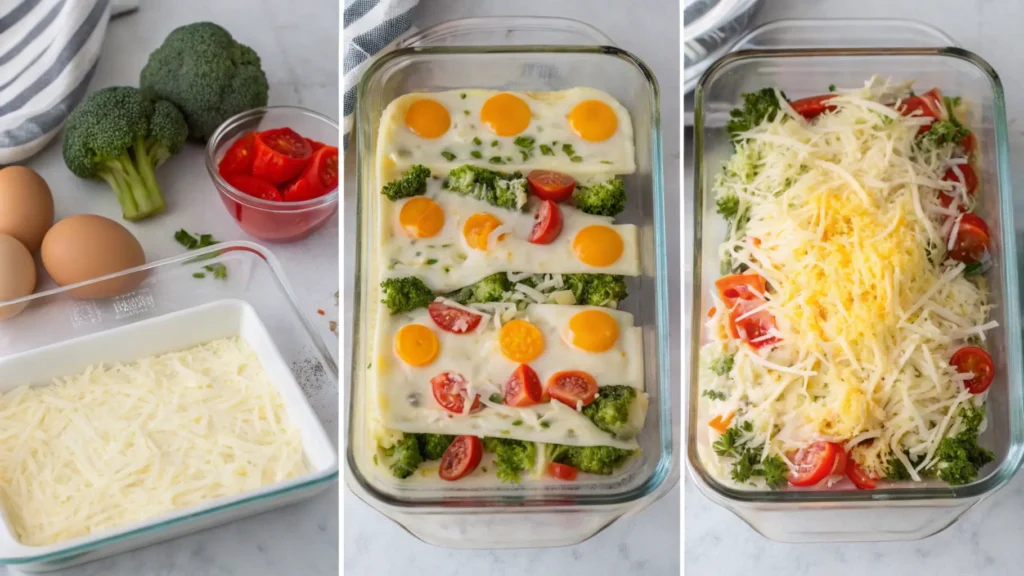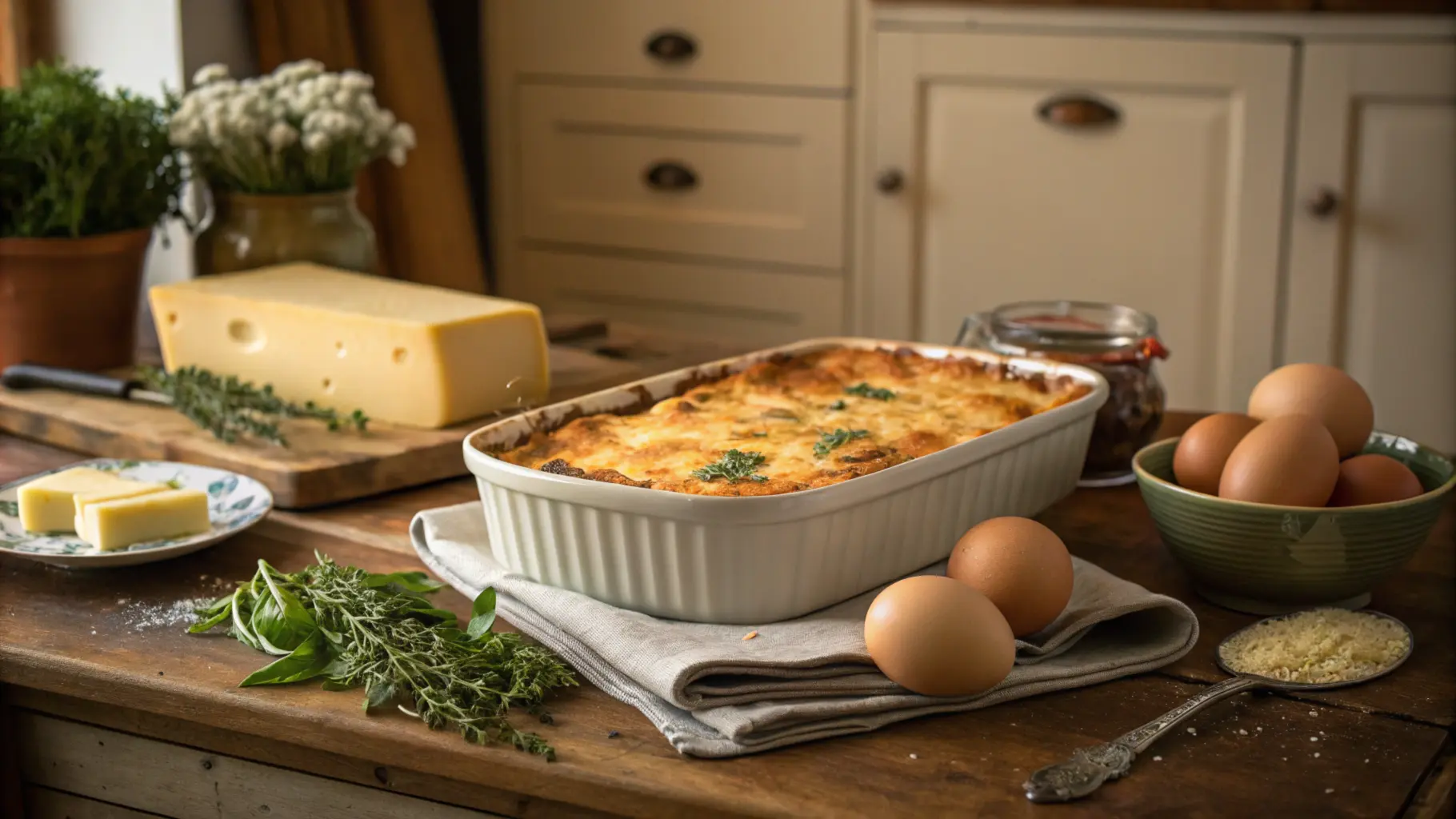Casseroles are the ultimate comfort food—versatile, hearty, and perfect for feeding a crowd. But when it comes to preparing them ahead of time, especially when raw eggs are involved, there are a few considerations you need to keep in mind. In this guide, we’ll explore whether you can safely make a casserole with raw eggs ahead of time, provide step-by-step tips for preparation and storage, and highlight ways to ensure food safety. Let’s dive in!
Understanding the Basics of Using Raw Eggs in Casseroles
What is a Casserole?
A casserole is more than just a dish; it’s a go-to solution for feeding families, hosting gatherings, or preparing make-ahead meals for busy weeks. The beauty of a casserole lies in its versatility. It’s a single-dish meal that combines ingredients like proteins, vegetables, grains, and dairy, baked together into a comforting dish.
Traditionally, casseroles are prepared in deep dishes, allowing the flavors to meld together during cooking. Whether it’s a cheesy breakfast casserole, a classic tuna noodle bake, or a hearty lasagna, casseroles are staples of homestyle cooking. Plus, they’re perfect for experimenting—swap out ingredients, and you’ll rarely go wrong. But can you make a casserole with raw eggs ahead of time? Understanding their role in this dish will help answer that.
The Role of Eggs in Casseroles
Eggs are a vital component of many casseroles, especially breakfast varieties. They act as a binding agent, holding the layers of ingredients together. Without eggs, the dish can lose its structure, falling apart when sliced or served. Beyond structure, eggs also provide moisture and richness, contributing to the casserole’s creamy texture.
In savory casseroles, eggs pair well with milk, cream, or cheese, creating a custard-like base that holds everything together. For sweet casseroles, like French toast bakes, eggs add that luxurious silkiness that makes the dish irresistible. Importantly, eggs help distribute flavors evenly throughout the casserole, ensuring every bite is just as delicious as the last.
Is It Safe to Use Raw Eggs?
Raw eggs can be safe to use if handled and cooked properly. One of the biggest concerns with raw eggs is salmonella, a type of bacteria that can cause foodborne illness. However, pasteurized eggs offer a safer option, as they’re heat-treated to kill harmful bacteria without changing their taste or texture.
If you plan to make a casserole with raw eggs ahead of time, be sure to follow safe food handling practices. Always store the prepared dish in the refrigerator and cook it thoroughly to an internal temperature of 160°F (71°C). This ensures the eggs are fully cooked and any potential bacteria are eliminated.
Additionally, check the quality of the eggs before using them. Fresh eggs have firm whites and vibrant yolks, which contribute to a better texture and flavor in your casserole. If you’re uncertain about the freshness, do the “float test”—place the egg in a bowl of water. If it sinks, it’s fresh; if it floats, it’s best to discard it.
Preparing a Casserole with Raw Eggs Ahead of Time

Why Make a Casserole Ahead of Time?
Life gets busy, and make-ahead meals are a lifesaver when schedules get hectic. Preparing a casserole ahead of time allows you to whip up a delicious meal without last-minute stress. It’s ideal for holidays, meal prepping, or feeding a crowd on a tight schedule. Plus, casseroles made in advance often taste better because the flavors have more time to meld together. But can you make a casserole with raw eggs ahead of time? Absolutely—if done correctly.
How to Properly Prepare a Raw Egg-Based Casserole in Advance
Preparing a casserole with raw eggs ahead of time isn’t as complicated as it sounds. Start by gathering fresh, high-quality ingredients. Follow your recipe to mix the raw eggs, dairy, and other components, ensuring everything is evenly combined. Next, layer or arrange the ingredients in your casserole dish.
To keep your dish fresh, cover it tightly with plastic wrap or an airtight lid. This prevents air exposure, which could dry out your casserole. Refrigerate it immediately; don’t let it sit at room temperature, as raw eggs can spoil quickly.
Storage Guidelines for Casseroles with Raw Eggs
When storing your prepared casserole, temperature is key. Keep it in the refrigerator at or below 40°F (4°C) and aim to cook it within 24 hours for the best quality and safety. If you need more time, freezing is an option, but it can slightly alter the texture of the dish. Always label your casserole with the date to track freshness. These precautions ensure you can enjoy your dish with confidence.
Cooking and Serving Pre-Made Casseroles
How to Cook a Casserole with Raw Eggs After Storage
Cooking a casserole with raw eggs after storage requires precision to ensure both safety and taste. Always preheat your oven to the temperature specified in the recipe—usually around 350°F (175°C). Bake the dish until the internal temperature reaches 160°F (71°C). This ensures that the raw eggs are fully cooked, eliminating any risk of foodborne illness. Use a food thermometer to check the center of the dish, as undercooked eggs can pose safety concerns.
Reheating and Serving Tips
If you’ve cooked the casserole in advance and need to reheat it, use a lower oven temperature—about 325°F (163°C)—to preserve the dish’s texture and avoid drying it out. Cover the casserole with foil during reheating to retain moisture. Serve it hot and fresh, pairing it with simple sides like salad or bread for a well-rounded meal.
So, can you make a casserole with raw eggs ahead of time? Yes, but handling and cooking it with care is essential. Following these tips will help you enjoy a flavorful, worry-free meal every time!
Safety and Quality Assurance
Ensuring Food Safety When Using Raw Eggs
Safety is the top priority when working with raw eggs in any recipe. Always use fresh, clean eggs, checking the expiration date before cracking them open. To reduce risks, wash your hands, utensils, and surfaces after handling raw eggs. If you’re concerned about bacteria, pasteurized eggs are a safer alternative that works perfectly in casseroles.
For casseroles made ahead of time, refrigeration is crucial. Store the dish below 40°F (4°C) to prevent bacterial growth. If you’re unsure whether the casserole has stayed at the proper temperature, it’s best not to take chances—when in doubt, throw it out.
How to Detect Spoilage in Stored Casseroles
Knowing when a casserole has gone bad is essential to avoid foodborne illnesses. Look for obvious signs like a sour smell, discoloration, or changes in texture. If you notice any liquid separation in the egg mixture or an unusually slimy appearance, it’s best to discard the dish. Sticking to storage recommendations is the best way to prevent these issues.
Using Pasteurized Eggs as a Safer Alternative
Pasteurized eggs are heat-treated to kill harmful bacteria without compromising their taste or texture. They are an excellent option for dishes like casseroles that involve raw eggs. Using pasteurized eggs ensures safety without sacrificing the creamy, custard-like quality that makes casseroles so delightful.
Creative Recipes and Variations
Popular Make-Ahead Casserole Recipes with Eggs
If you’re wondering, “Can you make a casserole with raw eggs ahead of time?” the answer opens up a world of delicious possibilities. There’s an abundance of recipes designed to be prepared in advance, combining convenience with flavor. Here are some popular options to inspire your next meal:
- Classic Breakfast Casserole: Packed with eggs, sausage, cheese, and hash browns, this casserole is a crowd-pleaser. Assemble it the night before, refrigerate, and bake it in the morning for a hassle-free breakfast. Add chopped vegetables like bell peppers or spinach for a healthy twist.
- Vegetarian Egg Bake: Loaded with seasonal veggies, this egg bake is perfect for meat-free mornings. Use ingredients like zucchini, mushrooms, and feta cheese for a Mediterranean-inspired flavor.
- Spinach and Mushroom Strata: This layered dish features bread cubes, eggs, cream, and sautéed spinach and mushrooms. It’s ideal for brunches or potlucks and can be customized with different types of bread or cheeses.
- Sweet French Toast Casserole: For a dessert-like breakfast, try a French toast casserole made with brioche, eggs, cinnamon, and maple syrup. Assemble it the night before, and let the bread soak up the egg mixture for a rich, custardy texture.
Looking for more ideas? Consider dishes like quiche bakes or tater tot casseroles—they’re just as easy to prepare ahead of time and offer endless variations.
Customizing Your Casserole with Additional Ingredients
One of the best parts about making casseroles is the ability to tailor them to your preferences. Whether you’re catering to dietary needs or experimenting with flavors, casseroles are a blank canvas. Here are some ideas to get you started:
- Vegetarian Options: Add roasted vegetables like sweet potatoes, broccoli, or butternut squash for a hearty, plant-based meal. Combine them with eggs and a cheese blend for a satisfying dish.
- Protein Boosts: For meat-lovers, include cooked bacon, ham, or chicken in your casserole. You can even try unconventional proteins like smoked salmon for a unique twist.
- Gluten-Free Choices: Replace traditional bread or pasta with gluten-free alternatives like rice, quinoa, or spiralized zucchini. These swaps make your casserole lighter and more nutrient-dense.
- Cheese and Herb Pairings: Experiment with different cheeses like gruyere, gouda, or goat cheese. Fresh herbs such as dill, thyme, or parsley can elevate the flavor profile of any casserole.
Customizing casseroles not only keeps them exciting but also makes them adaptable to various occasions. From cozy family dinners to festive holiday brunches, casseroles are versatile, delicious, and always in style.
FAQs: Common Questions About Casseroles with Raw Eggs
Can I Freeze a Casserole with Raw Eggs?
Yes, you can freeze a casserole with raw eggs, but it requires careful preparation. Freezing can slightly change the texture of the eggs, making them less smooth after cooking. To minimize this, use pasteurized eggs or mix the eggs with other ingredients like milk or cream before freezing. Wrap the dish tightly with plastic wrap and aluminum foil, or use a freezer-safe airtight container. Always label it with the date, and aim to cook it within 1-2 months for the best results.
What Happens if I Use Too Many Eggs in a Casserole?
Adding too many eggs to a casserole can create a dense, rubbery texture instead of the soft, creamy consistency you want. Eggs are a binding agent, so balance is key. If you’ve already added extra eggs, try increasing the amount of milk or cream to counteract the firmness. Proper proportions ensure the casserole stays moist and flavorful.
Is It Safe to Leave a Raw Egg Casserole Out Overnight?
No, it’s not safe to leave a raw egg casserole out overnight. At room temperature, bacteria can multiply quickly, especially in egg-based dishes. If left out for more than two hours, the casserole should be discarded to prevent foodborne illness. Always refrigerate the dish promptly to keep it fresh and safe to eat.
Can you make a casserole with raw eggs ahead of time? The answer is a resounding yes—but only if you follow proper storage and safety practices. With these tips, you can enjoy a delicious, hassle-free meal that’s ready when you need it.
For more delicious recipes and cooking tips, check out Recipes Fastly for inspiration!

